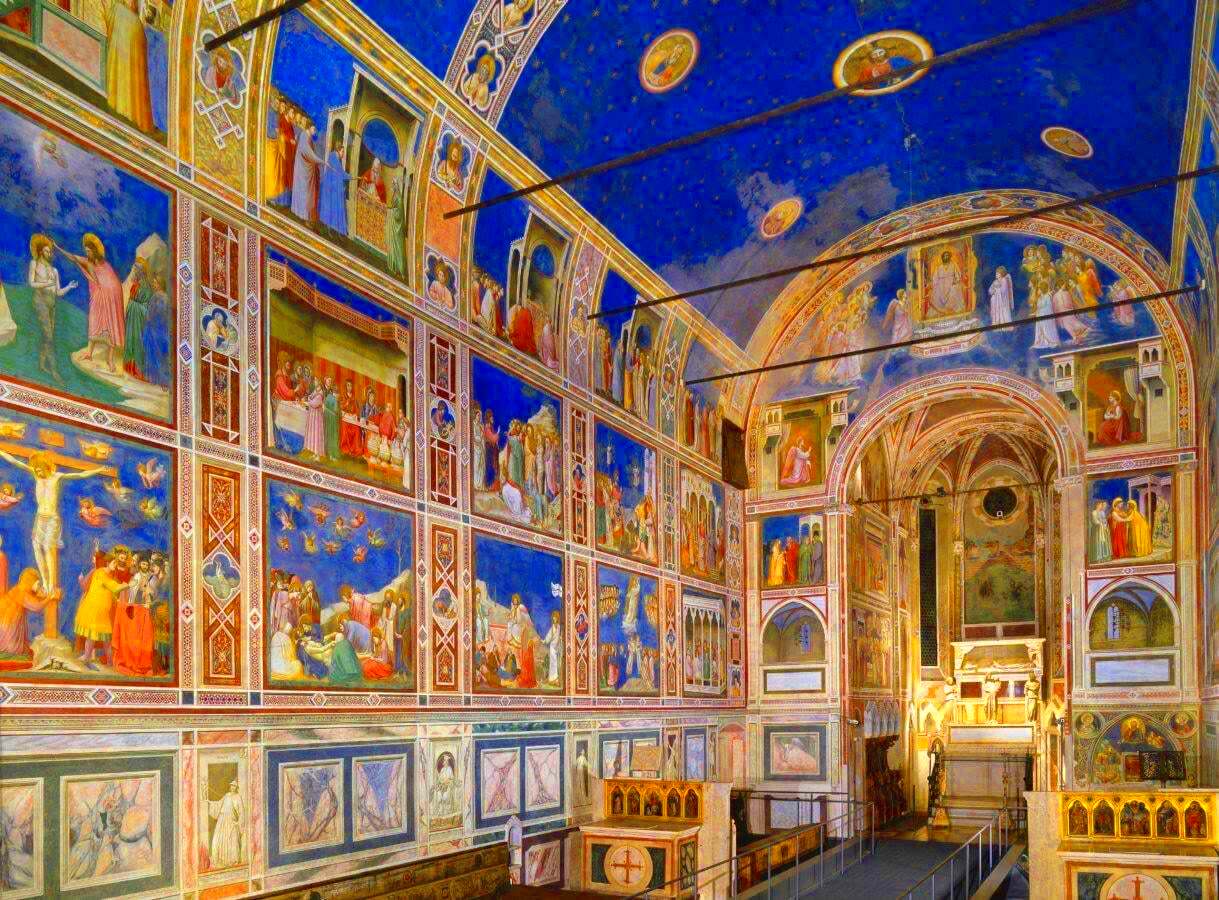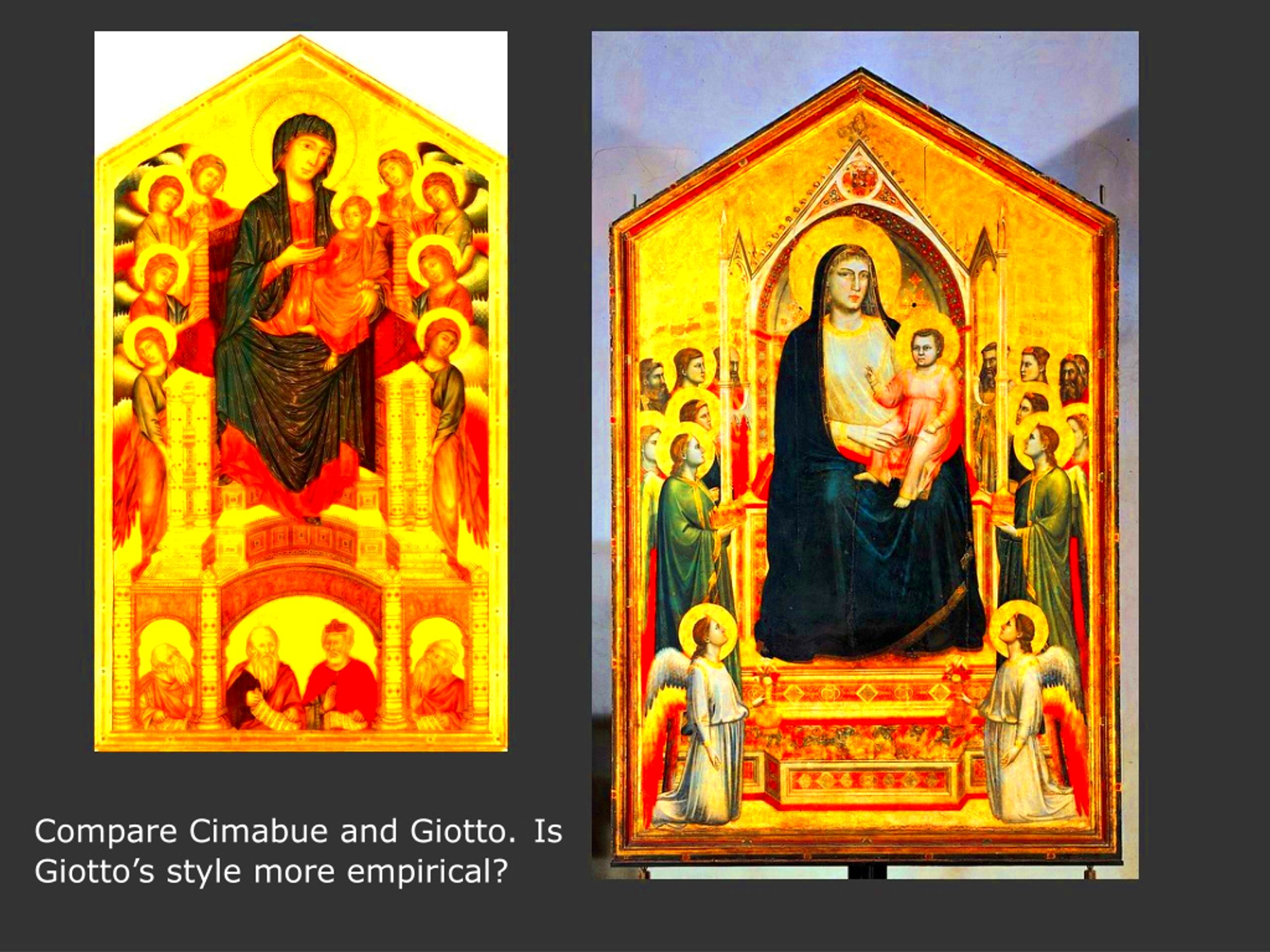There were many people who were significant in the transition from Byzantine art to Renaissance art, and Giotto di Bondone and Cimabue occupied such positions. Their works have individual traits, but they also denote a time when paintings began being produced with another kind of space representation. On one hand, the paintings of Cimabue appear flat while they contain some religious symbols; on the other hand, Giotto’s pictures possess some depth and realism. The purpose of this blog entry is to explicate how each artist portrays space as well as show how these styles have transformed the field of arts.
Understanding Giotto’s Artistic Approach to Space

In terms of space, Giotto’s method is ground-breaking for his era. Some features that define his technique include:
- Realism: Giotto moved away from the flat, two-dimensional figures common in Byzantine art. He aimed to create lifelike characters that seemed to inhabit a three-dimensional space.
- Perspective: He introduced the early concept of perspective, using overlapping figures and varying sizes to create a sense of depth.
- Backgrounds: Giotto often included detailed backgrounds, which helped ground his figures in a realistic environment, making the scenes more relatable.
Giotto became a trailblazer in the representation of space in art thanks to these techniques that enabled explainers to delve into the art more interactively.
Exploring Cimabue’s Depiction of Space

Cimabue, even though he preceded Giotto, had an alternative way of illustrating space. His art is stronger impacted by the Byzantine style as can be seen in various ways:
- Flatness: Cimabue’s figures often appear more two-dimensional, lacking the depth seen in Giotto’s work.
- Symbolism: He focused on conveying religious messages rather than realism, which sometimes resulted in less attention to the spatial arrangement.
- Gold Backgrounds: Many of Cimabue's works feature gold leaf backgrounds, creating a flat, otherworldly effect that emphasizes the divine rather than the earthly space.
In spite of these distinctions, it was the work of Cimabue that helped to pave way for innovations by Giotto; hence, both artists were crucial figures in art evolution during this time.
Influence of Giotto and Cimabue on Future Artists
These are two individuals who not only influenced their own era but also left an indelible mark on subsequent generations of artists. The two artists had contrasting styles and techniques, which made a way for new potentials in the world of art. Let’s take a look at how each artist contributed to the development of art:
- Giotto as a Pioneer: Giotto is often hailed as the father of the Renaissance. His innovative approaches to perspective and realism set the stage for artists like Masaccio, who further developed these concepts. Masaccio’s use of linear perspective in works like “The Holy Trinity” clearly echoes Giotto’s influence.
- Cimabue’s Symbolism: While Giotto pushed for realism, Cimabue’s emphasis on symbolism paved the way for future artists to explore deeper meanings in their work. His style can be seen in the works of later Gothic artists who favored spiritual narratives over strict realism.
- Combined Legacies: Both artists contributed to the shift from medieval to Renaissance art, blending spiritual themes with emerging realism. Their techniques influenced countless artists, including Michelangelo and Raphael, who incorporated elements of both Giotto’s and Cimabue’s styles into their masterpieces.
Basically, the legacies of Giotto and Cimabue remain in the art world, making us aware of that important point in time where they marked in the development of artistic language.
Frequently Asked Questions
Let’s address some frequently asked questions about Giotto, Cimabue, and their art:
- Who was Giotto? Giotto di Bondone was a 14th-century Italian painter known for his realistic style and use of perspective.
- What is Cimabue known for? Cimabue, also a 14th-century painter, is celebrated for his contributions to the Gothic style and his symbolic representations in art.
- How did Giotto change art? Giotto introduced realistic figures and spatial depth, moving away from the flatness of Byzantine art, which influenced many future artists.
- What are some famous works of Giotto? Notable works include the Scrovegni Chapel frescoes and the Ognissanti Madonna.
- How did Cimabue influence Giotto? Cimabue’s symbolic approach laid the groundwork for Giotto’s innovations, combining spiritual themes with realistic representation.
By considering these inquiries and their respective responses, we are able to have an enhanced comprehension of what Giotto and Cimabue contributed towards art globally.
Conclusion on the Differences in Space Depiction
In conclusion, the manner in which Giotto and Cimabue portrayed space shows a major development of artistic skills and philosophies. For example, Cimabue’s work displays the spiritual flatness of Byzantine art wherein symbolism and emotional qualities are emphasized while Giotto’s new style incorporates perspective and naturalism. To summarize their main differences briefly:
| Aspect | Cimabue | Giotto |
|---|
| Perspective | Flat and symbolic | Realistic and three-dimensional |
| Use of Light | Minimal shadowing | Chiaroscuro techniques |
| Color Application | Bold and symbolic | Naturalistic and varied |
Broadly speaking, these distinctions are mirrored in the transformation of art from medieval to Renaissance. By grasping such subtlety, we not only understand their works better but also notice how fast art can change.
 In terms of space, Giotto’s method is ground-breaking for his era. Some features that define his technique include:
In terms of space, Giotto’s method is ground-breaking for his era. Some features that define his technique include: Cimabue, even though he preceded Giotto, had an alternative way of illustrating space. His art is stronger impacted by the Byzantine style as can be seen in various ways:
Cimabue, even though he preceded Giotto, had an alternative way of illustrating space. His art is stronger impacted by the Byzantine style as can be seen in various ways:
 admin
admin








